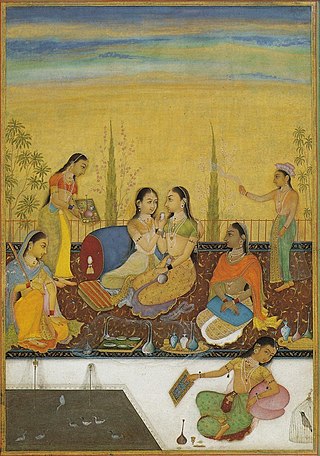Related Research Articles

Jahanara Begum was a princess of the Mughal Empire. She was the second and the eldest surviving child of Mughal Emperor Shah Jahan and Mumtaz Mahal.
The Muzaffarid dynasty, sometimes referred as Ahmedabad dynasty, were Sultans of Gujarat in western India from 1391 to 1583. The founder of the dynasty was Zafar Khan who was governor of Gujarat under the suzerainty of the Tughlaq dynasty of the Delhi Sultanate. When the Sultanate was weakened by the sacking of Delhi by Timur in 1398, and Zafar Khan took the opportunity to establish himself as sultan of an independent Gujarat. His Grand son, Ahmed Shah I established the capital at Ahmedabad. The dynasty ruled for almost 200 years, until the conquest of Gujarat by the Mughal Empire in 1572. The sultanate reached its peak of expansion under Mahmud Begada, reaching east into Malwa and west to the Gulf of Kutch.

Anarkali is a legendary woman said to be loved by the 16th-century Mughal Prince Salim, who later became Emperor Jahangir. According to some accounts, Anarkali was the nickname of the tawaif Sharf-un-Nisa, though scholars hold varying opinions.

Zenana literally meaning "of the women" or "pertaining to women", in the Persian language contextually refers to the part of a house belonging to a Muslim, Sikh, or Hindu family in the Indian subcontinent, which is reserved for the women of the household. The zenana was a product of Indo-Islamic culture and was commonly found in aristocratic Muslim families. Due to prolonged interactions between Hindus and Muslims, upper-class Hindu households, inclined to imitate elite cultural trends, also embraced these designated spaces. The zenana were the inner rooms of a house where the women of the family lived and where men and strangers were not allowed to enter. The outer apartments for guests and men are called the mardana. Conceptually in those that practise purdah, it is the equivalent in the Indian subcontinent of the harem.
Kishori Saran Lal (1920–2002), better known as K. S. Lal, was an Indian historian. He is the author of several works, mainly on the medieval history of India.

Manavati Bai, also spelled Manvati Bai,, better known by her title, Jagat Gosain, was the second wife and the empress consort of the fourth Mughal emperor Jahangir and the mother of his successor, Shah Jahan.
Bega Begum was Empress consort of the Mughal Empire from 26 December 1530 to 17 May 1540 and 22 February 1555 to 27 January 1556 as the first wife and chief consort of the second Mughal emperor Humayun. She was known as Zan-i-Kalan being the first wife of Humayun and was also known as Haji Begum after she performed the Hajj pilgrimage.

Sahib Jamal was the wife of Prince Salim, the future Mughal emperor Jahangir and the mother of his second son, Prince Parviz.

The Mughal Harem was the harem of Mughal emperors of the Indian subcontinent. The term originated with the Near East, meaning a "forbidden place; sacrosanct, sanctum", and etymologically related to the Arabic حريم ḥarīm, "a sacred inviolable place; female members of the family" and حرام ḥarām, "forbidden; sacred". It has the same meaning as the Turkish word seraglio and the Persian word zenana. It is also similar to the Sanskrit word anthapura, meaning ‘the inner apartment’ of the household. It came to mean the sphere of women in what was usually a polygynous household and their segregated quarters which were forbidden to men.
Zainab Sultan Begum was Queen consort of Ferghana Valley and Kabul as the second wife of Emperor Babur. She like two of his other wives Aisha Sultan Begum and Masuma Sultan Begum was a direct cousin of the Babur.
During the Mughal Dynasty, urdubegis were the class of women assigned to protect the emperor and inhabitants of the zenana.
Tehwildars in the Mughal court, were the female financial officers assigned to the zenana.
Saliha Banu Begum was the chief consort of Emperor Jahangir. She was the Padshah Begum for the most part of the reign of her emperor husband until her death in the year 1620.
The Tomaras of Gwalior were a dynasty who ruled the Gwalior Fort and its surrounding region in central India during 14th–16th centuries. They are known for their patronage to the cultural activities in Gwalior.
Nusrat Khan was a general of the Delhi Sultanate ruler Alauddin Khalji. He served as Alauddin's wazir during the start of his reign, and played an important role in the Sultan's Devagiri (1296) and Gujarat (1299) campaigns. He was killed during the Siege of Ranthambore in 1301.
Hazrat Begum, also known as Hazrat Mahal and Sahiba Begum, was a Mughal princess, as the daughter of Mughal Emperor Muhammad Shah. She was a wife of Ahmad Shah Durrani, the first emir of the Durrani Empire.
Malika Jahan was a Jaisalmer princess, and wife of Mughal emperor Jahangir.

A qaba is a long coat with sleeves and buttons, similar to a cassock, open at the front. A qaba is similar to a wadded coat. It is considered of Turkic origin.
After the mid-16th century, many Rajput rulers formed close ties with the Mughal emperors and served them in various capacities. It was because of the Rajputs that Akbar was not able to make complete Mughal Empire in India. The Rajput thakurs, who offered their daughters for marriage, formed a strong tie with the Timurid house of the Mughal Empire. The Rajput vassals had their daughters and sisters married to the Mughal emperors and their princes. For example, Akbar performed 40 marriages comprising for himself, his sons and grandsons, of which 17 were Rajput-Mughal alliances. The successors of the Mughal emperor Akbar, the mothers of his son Jahangir and grandson Shah Jahan were Rajputs. The Sisodia Rajput family of Mewar made it an honor not to enter into matrimonial relations with the Mughals, and thus stood in contrast to all other Rajput clans. After this time, the marital relations between the Rajputs and the Mughals declined somewhat. Akbar's relations with the Rajputs began when he returned in 1561 from a visit by the Chisti Sufi Shaikh of Sikri, west of Agra. Then many Rajput princesses married Mughal emperor Akbar.
References
- 1 2 Carotenuto, Gianna M. (2009). Domesticating the harem: Reconsidering the zenana and representations of elite Indian women in colonial painting and photography of India, 1830–1920 (Thesis). University of California, Los Angeles. p. 59, 61-62.
- 1 2 Tahera Aftab (2008). Inscribing South Asian Muslim Women: An Annotated Bibliography & Research Guide. BRILL. p. 45. ISBN 978-90-04-15849-8.
- ↑ Bano, Shadab (1999). "Marriage and Concubinage in the Mughal Imperial Family". Proceedings of the Indian History Congress. 60: 353–362. ISSN 2249-1937.
- ↑ Parveen, Layma (November 2023). "The Two Shades Of Mughal Harem: Chastity And Debauchery" (PDF). International Journal of Creative Research Thoughts. 11 (11).
- ↑ Waheed, Usman; Numan, Muhammad (2024-03-30). "From Harems to Thrones: The Ascendancy of Women in Mughal Royalty" (PDF). Cognizance Journal of Multidisciplinary Studies. 4 (3): 107–126. doi:10.47760/cognizance.2024.v04i03.011.
- ↑ Lal, Ruby (2004). "Historicizing the Harem: The Challenge of a Princess's Memoir". Feminist Studies. 30 (3): 590–616. doi:10.2307/20458986. ISSN 0046-3663.
- ↑ Lal, Kishori Saran (April 1, 1988). The Mughal Harem (1st ed.). India: Aditya Prakashan. pp. 01–18. ISBN 9788185179032.
{{cite book}}: CS1 maint: date and year (link) - ↑ Lal, Kishori Saran (April 1, 1988). The Mughal Harem (1st ed.). India: Aditya Prakashan. pp. 01–50. ISBN 9788185179032.
{{cite book}}: CS1 maint: date and year (link) - ↑ Lal, Kishori Saran (April 1, 1988). The Mughal harem (1st ed.). India: Aditya Prakashan. pp. 01–207. ISBN 9788185179032.
{{cite book}}: CS1 maint: date and year (link) - ↑ Lal, Kishori Saran (April 1, 1988). The Mughal Harem (1st ed.). India: Aditya Prakashan. pp. 01–207. ISBN 9788185179032.
{{cite book}}: CS1 maint: date and year (link) - ↑ Lal, Kishori Saran (April 1, 1988). The Mughal Harem (1st ed.). India: Aditya Prakashan. pp. 193–207. ISBN 9788185179032.
{{cite book}}: CS1 maint: date and year (link) - 1 2 3 Anjum, Faraz. "Strangers' Gaze: Mughal Harem and European Travellers of the Seventeenth Century" (PDF). Pakistan Vision. 12 (1).
- ↑ Lal, Ruby (2004). "Historicizing the Harem: The Challenge of a Princess's Memoir". Feminist Studies. 30 (3): 590–616. doi:10.2307/20458986. ISSN 0046-3663.
- ↑ Waheed, Usman; Numan, Muhammad (2024-03-30). "From Harems to Thrones: The Ascendancy of Women in Mughal Royalty". Cognizance Journal of Multidisciplinary Studies. 4 (3): 107–126. doi:10.47760/cognizance.2024.v04i03.011. ISSN 0976-7797.
- ↑ Indian Historical Review, New Delhi, 1991
- ↑ Lal, Ruby (2004). "Historicizing the Harem: The Challenge of a Princess's Memoir". Feminist Studies. 30 (3): 592. doi:10.2307/20458986. ISSN 0046-3663. JSTOR 20458986.
- ↑ Sharma, Karuna (2009-07-10). "A Visit to the Mughal Harem: Lives of Royal Women". South Asia: Journal of South Asian Studies. 32 (2): 156. doi:10.1080/00856400903049457. S2CID 144568032.
- ↑ Chatterjee, Indrani (1996). Slavery and the household in Bengal, 1770-1880 (Thesis). School of Oriental and African Studies. p. 24.
- ↑ Harbans, Mukhia (2004), "Select Bibliography", The Mughals of India, John Wiley & Sons, Ltd, p. 188, doi: 10.1002/9780470758304.biblio , ISBN 978-0-470-75830-4
- ↑ Powell, A. A. (June 1995). "K. S. Lal: The legacy of Muslim rule in India, vi, 406 pp. New Delhi, Aditya Prakashan, 1992". Bulletin of the School of Oriental and African Studies. 58 (2): 397–398. doi:10.1017/S0041977X0001123X. ISSN 1474-0699. S2CID 161966133.
- 1 2 Bano, Shadab (1999). "Marriage and Concubinage in the Mughal Imperial Family". Proceedings of the Indian History Congress. 60: 353–362. ISSN 2249-1937.
- ↑ Parveen, Layma (November 2023). "The Two Shades Of Mughal Harem: Chastity And Debauchery" (PDF). International Journal of Creative Research Thoughts (IJCRT). 11 (11): 545–553 – via IJCRT.
- ↑ 1 Kaur; 2 Ananya; 3 Mishra, 1 Dr. Daljit; 2 Shubhanshi (April 2022). "Mughal Harems: An Intricate Affair" (PDF). International Journal of Novel Research and Development. 7 (4): 993–999 – via IJNRD.
{{cite journal}}: CS1 maint: multiple names: authors list (link) CS1 maint: numeric names: authors list (link)